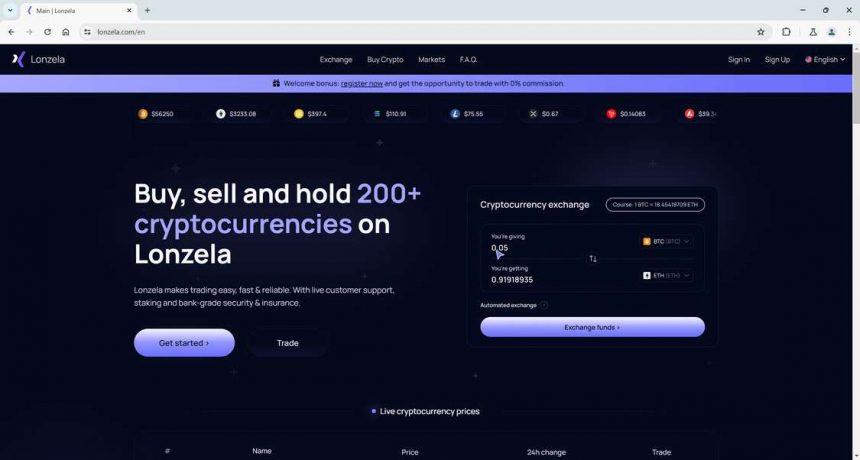In the ever-evolving landscape of cybersecurity threats, the Lonzela crypto scam has emerged as a dangerous dual menace, combining deceptive practices with the deployment of Trojan Horse malware. This sophisticated scheme preys on unsuspecting crypto enthusiasts, enticing them with promises of substantial gains and celebrity affiliations. However, beneath the veneer of enticing rewards lies a malicious intent to deplete funds and compromise user devices.
Understanding Lonzela
Lonzela is part of a complex network of scams, potentially originating from China, and is intricately connected to other suspicious platforms like Somezex, Nowzex, and Trestorex. The scam operates by masquerading as a legitimate cryptocurrency exchange, using uniform website layouts and repeated legal terms across multiple platforms to create an illusion of authenticity. The integration of Trojan malware into Lonzela exacerbates the risks, as it stealthily infiltrates users’ devices, siphoning off confidential information and engaging in harmful activities such as cryptocurrency mining.
The Lonzela Bitcoin Scam is a manifestation of the broader crypto fraud wave, characterized by common warning signs such as uniform website layouts, dubious endorsements, and a pyramid-like referral scheme. The scam lures victims through social media platforms like Facebook and TikTok, utilizing fake profiles or bots to distribute referral codes and promising substantial crypto gifts. The use of fake Elon Musk endorsements intensifies the allure, leading users to a seemingly authentic website.
Once on the deceptive platform, victims submit personal information, including crypto wallet details and identification papers. The scam escalates as victims, enticed by illusory rewards, discover a catch – a mandatory deposit to withdraw the promised crypto. After depositing around $100, communication is abruptly cut off, and the fraudsters vanish with both the deposit and vital personal data, leaving victims ensnared in a web of deception.
Lonzela.com is the latest iteration of the scam, employing deepfake videos of celebrities like Cristiano Ronaldo and Elon Musk. Scammers use these videos to trick fans into depositing Bitcoin on the fake site by promising free crypto giveaways activated through promo codes. The scam involves a step-by-step process, starting with the production of fake celebrity endorsement videos using deepfake technology and voice dubbing. These videos are then distributed on social media platforms through paid ads and hashtag campaigns.
Victims who fall for the scam enter promo codes on the Lonzela.com site, leading to a fake balance being added to their accounts. However, attempts to withdraw these funds result in a message requiring a minimum deposit to “activate” withdrawals. This cunning tactic tricks users into sending real Bitcoin payments, which the scammers promptly steal. The fraudulent platform and celebrity-endorsed giveaways are revealed to be non-existent, leaving victims with no recourse to recover their funds.
The Trojan Horse malware associated with Lonzela represents a serious threat to users’ cybersecurity. These Trojans, distributed through unsolicited emails, covertly infiltrate users’ systems. Once inside, they not only steal confidential information but also engage in cryptocurrency mining, depleting computing resources and causing other harmful actions. The consequences of such malware infections extend beyond financial losses, posing a substantial risk to user privacy and system integrity.
Detection Names and Similar Threats
The Trojan Horse malware linked to Lonzela may be detected by various security solutions under different names, including but not limited to:
- Trojan.Lonzela
- Trojan.CryptoMine
- Trojan.MailSpoofer
Similar threats in the cyber landscape include schemes associated with Somezex, Nowzex, and Trestorex, reflecting the interconnected nature of these deceptive platforms.
Removal Guide
Removing the Lonzela-related malware requires a comprehensive and meticulous approach. Follow these steps to ensure a thorough removal process:
- Isolate the Infected Device: Disconnect the infected device from the network to prevent further data leakage or damage.
- Identify Malicious Processes: Use the Task Manager (Ctrl+Shift+Esc) to identify and terminate any suspicious processes associated with the malware.
- Delete Malicious Files: Navigate to the system directories and user folders to delete any files associated with the Trojan malware.
- Registry Cleanup: Use the Registry Editor (regedit) to remove any registry entries created by the malware. Exercise caution and back up the registry before making changes.
- Safe Mode Scanning: Boot the system into Safe Mode and perform a thorough antivirus scan using a reputable security solution.
- Restore System Settings: Reset system settings to a state before the malware infection occurred. Use System Restore or a similar feature.
- Update Security Software: Ensure that your antivirus and anti-malware programs are updated to their latest versions to enhance protection against emerging threats.
Best Practices for Prevention
Preventing future infections requires a proactive approach and adherence to best practices:
- Exercise Caution on Social Media: Be skeptical of unsolicited offers and giveaways on social media platforms, especially those endorsed by celebrities.
- Verify Website Authenticity: Thoroughly vet cryptocurrency platforms before making any investments. Look for consumer reviews, industry appraisals, and operational transparency.
- Beware of Unrealistic Offers: Be cautious of offers that seem too generous or implausible. Scammers often use enticing promises to lure victims.
- Verify Celebrity Endorsements: Verify celebrity endorsements from reputable news outlets before trusting them as genuine. Celebrities rarely engage in unsolicited giveaways.
- Avoid Unknown Software and Links: Refrain from downloading unknown software or clicking on suspicious links, as these may lead to malware infections.
- Implement Robust Antivirus Measures: Use reliable antivirus utilities and conduct routine system audits to detect and remove potential threats.
Conclusion
The Lonzela crypto scam, with its blend of deceptive practices and Trojan Horse malware, underscores the critical need for user vigilance and cybersecurity measures. By understanding the modus operandi of such scams, exercising caution on online platforms, and implementing robust security practices, users can shield themselves from falling victim to these sophisticated cyber threats.





